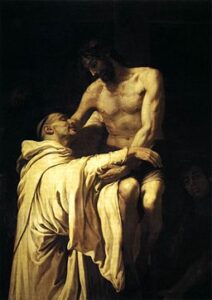Literary Persons and Medieval Fiction in Bernard of Clairvaux’s Sermons on the Song of Songs
by Julie Orlemanski
 Like many exegetes before him, the twelfth-century Cistercian abbot Bernard of Clairvaux regarded the lovers in the Song of Songs as allegorical fictions. Yet these prosopopoeial figures remained of profound commentarial interest to him. Bernard’s Sermons on the Song of Songs returns again and again to the literal level of meaning, where text becomes voice and voice becomes fleshly persona. This essay argues that Bernard pursued a distinctive poetics of fictional persons modeled on the dramatic exegesis of Origen of Alexandria as well as on the Song itself. Ultimately, the essay suggests, Bernard’sSermons form an overlooked episode in the literary history of fiction.
Like many exegetes before him, the twelfth-century Cistercian abbot Bernard of Clairvaux regarded the lovers in the Song of Songs as allegorical fictions. Yet these prosopopoeial figures remained of profound commentarial interest to him. Bernard’s Sermons on the Song of Songs returns again and again to the literal level of meaning, where text becomes voice and voice becomes fleshly persona. This essay argues that Bernard pursued a distinctive poetics of fictional persons modeled on the dramatic exegesis of Origen of Alexandria as well as on the Song itself. Ultimately, the essay suggests, Bernard’sSermons form an overlooked episode in the literary history of fiction.
Image: Francisco Ribalta, Christ embracing Saint Bernard, Museo del prado, madrid
The essay begins:
Osculetur me osculo oris sui. “Let him kiss me with the kiss of his mouth.” In the first words of the Song of Songs, a voice announces itself, and with it, a corporeal figure comes flickeringly into existence. A voice speaks from the page and summons a body around it. The utterance implies a literary person not merely in the sense in which Quintilian explains the trope of prosopopoeia or fictio personarum, remarking, “We cannot of course imagine a speech except as the speech of a person.” No, with its first-person object, “Let him kiss me,” the textual voice refers to its own body, a body that can be kissed, with a mouth that is an organ not just of speech but of sensation and erotic action. The o of this open mouth—of the speaker’s mouth but also of any reader who reads the words aloud—is echoed visually on the written page: Osculetur . . . osculo oris. In a medieval manuscript, the initial capital would likely be written on a larger scale, emphasizing the graphic dimensions of the letter, and in an illuminated Bible it might even be filled the with the image of a man and a woman kissing. In the likeness shared between the o of the speaker’s mouth as she seeks a kiss, the o of a reader’s mouth pronouncing the verse, and the o of the letters on the manuscript page, the mixed ontology of literary persons shimmers into view. Is this utterance, Osculetur me osculo oris sui, something that I perceive or something I do? Where is the body that speaks? Suspended between a scene to watch and a script to follow, it seems to belong at once to mimesis and performance, fiction and rhetoric.
This verse’s associative movement from text to corporealization was a point of fascination for readers and writers in the Middle Ages. Its sudden drama, its intimate but peculiar phrasing, and the crosshatched invitations both to watch a spectacle of desire unfolding and to make this speaker’s voice one’s own helped render the Song of Songs the most frequently interpreted biblical book in medieval Christianity. The present essay considers an especially sophisticated and influential instance of that exegesis, the Sermons on the Song of Songs (Sermones super Cantica Canticorum, hereafter SCC) by Bernard of Clairvaux (d. 1153), an undertaking that occupied the final eighteen years of the Cistercian abbot’s life and that survives in more than a hundred manuscripts.
In the first of the eighty-six sermons in the collection, Bernard launches his consideration of the language of the Song by imploring, “Tell us, I beg you, by whom, about whom, and to whom it is said: ‘Let him kiss me with the kiss of his mouth.’” Bernard’s words, we might notice, are at once a breathless plea for language to explain the personae it proliferates and, too, a canny enactment of that proliferation, conjuring an I, a you, and a we of its own. Grammatical persons multiply, and Bernard presses the urgency of their reference. In effect, he plunges his audience into a fundamental problem of understanding the Song. Because the Song consists entirely of direct speech, a series of unattributed lyric utterances, even the most rudimentary sense-making requires figuring out who is talking to whom. As Bernard begins to describe these speakers, his exegesis shows itself quiveringly alert to the operations of pronominal reference, deixis, and other indices of address. But it is not only the correct identification of speakers that interests him. These speakers become, I suggest, rhetorical resources for the SCC. Bernard’s preacherly style pursues a distinctive poetics of fictional persons, modeled in part on the Song of Songs itself. In its twelfth-century context, the SCC articulated new explanations for the Song’s carnal rhetoric of fictional bodies and, at the same time, operationalized that rhetoric in a distinctive program of literary experience.
What does it mean to discuss the Song of Songs in terms of fiction? From the point of its incorporation into the Hebrew Bible, the Song raised questions about the interpretive status of its central figures, a feminine and a masculine speaker who are accompanied intermittently by a chorus of companions. Nowhere are God or his chosen people mentioned. Jewish and early Christian exegetes concurred that the Song’s extraordinarily frank erotic images—“your breasts better than wine,” “his left arm under my head and his right hand will embrace me,” “your lips drip honeycomb”—were not to be interpreted straightforwardly, referring to actual individuals’ erotic love. Rabbis in the second and third centuries taught that the Song was a figuration of the love between God and the people of Israel, and the early Christian commentary of Hippolytus of Rome (d. c. 236) followed suit with an ecclesiological interpretation. The foundation for the Song’s exegesis in the Latin West was undoubtedly Origen of Alexandria (d. c. 253), whose Commentary on the Song of Songs (Commentarium in Cantica Canticorum), brought together the allegory of the church with that of the individual soul: the book is sung “after the fashion of a bride to her bridegroom, who is the word of God, burning with heavenly love. And deeply indeed did she love him, whether we take her as the soul made in his image or as the church.” The ecclesiological interpretation prevailed in subsequent centuries, shaping influential commentaries by Pope Gregory I (d. 604) and the Venerable Bede (d. 735), until the twelfth century, when tropological interpretation, focused on the individual soul, became a prominent framework as well, thanks especially to Bernard’s influential sermons.
For most medieval readers, then, the bodies conjured by the Song of Songs were rhetorical specters, effects of a divinely inspired discourse. Bernard fits squarely within this tradition of regarding the Bride and Bridegroom as allegorical fictions—but he does so with a crucial difference. The fictive bodies of the Song remained of profound commentarial interest to him. Unlike other medieval exegetes, who largely ignored the literal level of meaning in their expositions, Bernard returned again and again to the mimetic operations of the Song’s language, in which text becomes voice and voice becomes fleshly, fictional persona. He not only engaged in the well-established practice of prosopological interpretation (or the effort to resolve scriptural ambiguity by identifying the personae of speakers and addressees) but also pursued those explanations into new prosopopoeial invention. In mixing interpretation and literary person-making, Bernard had several models at his disposal. These included the devotional recitation of the Psalms in the Divine Office, the schoolroom exercise of adlocutio or prosopopoeia, and, finally, the “dramatic” analysis offered in the Commentary by Origen. Although Bernard has long been recognized as having revived Origen’s focus on the individual, tropological significance of the Song, I suggest that the Alexandrian’s tendency to amplify the Song’s fictive scenes in a self-consciously theatrical mode was also an important influence on the SCC. Both Origen’s Commentary and Bernard’s Sermons consolidate the Song’s fleetingly evoked personae into durable referents that sustain the extended exercise of imagination.
It is true that Bernard does not refer to the Song of Songs as a fiction (fictio or res ficta), nor does he draw on closely related terms like fabula and poetria—terms colored by their association with the works of pagan authors. The abbot shows little interest in such idioms of medieval literary theory. Instead, it is at the level of rhetorical design that his sermons testify to a fascination with what might be called the cognitive realities of fiction, or how language induces mental images that provoke sensory and emotional responses in an audience. In the case of the eroticized bodies of the Song, however, those images were possessed of a crucial unreality as well. If exegetical tradition had colored the Song’s celebration of heterosexual love with a certain tincture of disbelief—looking past carnal passion to spiritual union—Bernard invited his audience into the willing suspension of that disbelief, as it were. Ultimately, I suggest, the Sermons form an overlooked episode in the history of literary fiction. Though the twelfth-century secular genres of courtly romance and Ovidian love poetry have loomed large in fiction’s historiography, devotional literature likewise contributed to the changing semantics of imaginative writing in the period.
In what follows, I concentrate my analysis on the figure of the Bride in the first nine sermons of the SCC to show how the sermons both comment on and incorporate the Song’s carnal rhetoric of fictional bodies. I then compare this prosopopoeial poetics to the Psalms performed in the Divine Office, grammar-school exercises in prosopopoeia, and, most extensively, to Origen’s Commentary on the Song. I suggest in closing that the mode of fictionality pursued in the SCC, one uniquely alert to the dynamics of reception and the mixed ontology of literary persons, sheds new light on twelfth-century developments in fiction. Continue reading free of charge for a limited time …
 JULIE ORLEMANSKI is Associate Professor of English at the University of Chicago. Her monograph Symptomatic Subjects: Bodies, Medicine, and Causality in the Literature of Late Medieval England appeared in 2019 and was shortlisted for the British Society for Literature and Science book prize. She is currently at work on two book-length projects. One concerns prosopopoeia in medieval writing. The other follows the tangled genealogies of fictionality and disenchantment to argue for a comparative poetics of fiction.
JULIE ORLEMANSKI is Associate Professor of English at the University of Chicago. Her monograph Symptomatic Subjects: Bodies, Medicine, and Causality in the Literature of Late Medieval England appeared in 2019 and was shortlisted for the British Society for Literature and Science book prize. She is currently at work on two book-length projects. One concerns prosopopoeia in medieval writing. The other follows the tangled genealogies of fictionality and disenchantment to argue for a comparative poetics of fiction.
